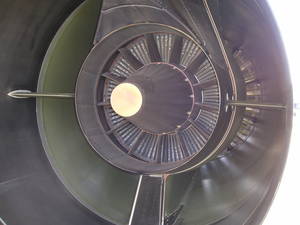Printing parts for planes
Interview with
Next time you go on holiday, chances are a jet engine will help you to get  there. These engines usually have a large fan at the front end - driven by engine - that pushes air backwards, propelling the plane forwards.
there. These engines usually have a large fan at the front end - driven by engine - that pushes air backwards, propelling the plane forwards.
The blades of these fans are precision-engineered to give them the very great strength and durability that they need to work reliably and safely. But this also makes them very expensive to manufacture and replace.
Engineers at the UK company Rolls-Royce have come up with a solution that means they can use a technique similar to 3D printing, to repair and strengthen worn fan blades. Graihagh Jackson spoke to Rolls-Royce engineer Martin Rawson to hear how it works...
Martin - So you could repair certainly aerofoils which are the rotating parts of the blades. The powder's delivered to a point above the aerofoil surface where you want to deposit the material and then you essentially use a laser beam to melt the powder as it arrives at that position. You can build those back up to their original shape, so you've got the original blade profile.
Graihagh - So why would you use this method over melting something down and starting from scratch?
Martin - One of the advantages of powder is that, of course, you can potentially take subtle difference in composition of powder and tailor them metallurgically to where they're most appropriate. So, you could also potentially in the rotating discs where you've got the sort of the outer of the rim of the disc which carries the blades is a lot hotter, for example, than the bore of the disc. So again you could look at changing the composition.
Graihagh - In the future, what sort of applications are we looking at?
Martin - I was in the AeroMat conference a few years ago where certainly NASA were interested in the use of powders for either building structures in space or for, I guess again, repairing components in space. They seem very interested in the technology, you know. The fact it was transportable. You could easily transport the powder, you could easily transport the machines. In terms of Rolls-Royce, so, prototype applications, development engines. I could see that things like 3D printing would have a real future in that sort of area. If you look back a number of years where we were using TIG welding techniques to actually build up components for the prototypes for development engines. That was a big benefit considering that to actually obtain the casting from a traditional route would take something like 12 months. So, I suppose, your imagination's the limits on that one in terms of what you could do.









Comments
Add a comment